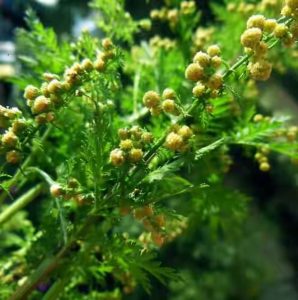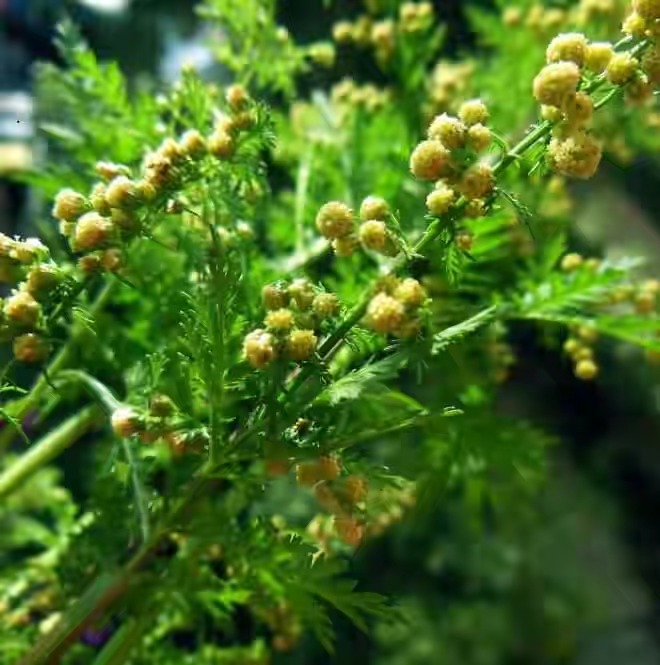Artemisia annua; synonym: Artemisia chamomilla (Botanical/scientific name) or Annual wormwood, Annual mugwort, Sweet wormwood, Chinese fragrant fern, Sweet Annie, Sweet sagewort (English) or Tazargade (Hausa): An annual plant famous for fighting malaria with chills and fever as well as to stop malarial attacks. Artemisia annua is the active ingredient in the Madagascar herbal remedy for coronavirus called COVID ORGANICS (CVO).
DESCRIPTION AND OCCURRENCE
Annual plant, aromatic, green, glabrous or with scattered, small, approximate hairs. Stem erect, ribbed, brownish or violet-brown, naturally grows to 30-100 cm high (cultivated plants may reach 200 cm high).
Leaves alveolate-punctateglandular; lower leaves petiolate, 3–5 cm long and 2–4 cm wide, ovate, thrice pinnatley cut, their lobules oblong-lanceolate, short-acuminate, entire or with 1-2 teeth, 1–2 mm long and 0.5 mm wide; middle and cauline leaves twice pinnately cut; upper leaves sessile, smaller and less compound; uppermost leaves bracteal, simple with fewer lateral lobes.
Capitula is globose, 2.0-2.5 mm in diameter, numerous, divergent or drooping, on short peduncles, approximate on short branches, usually in long pyramidal paniculate inflorescence.
Involucre is glabrous. Outer involucral bracts are linear-oblong, green; inner oval or almost round, with wide scarious border, lustrous. Receptacle is convex, glabrous.
Peripheral florets pistillate, 10-20, filiform, punctate-glandular; their stigma lobes narrowly linear, obtuse, exserted from corolla tube; disk florets bisexual, 10-30, their corollas cupshaped-tubular, glabrous; anthers narrowly linear, apical appendages of anthers long, acute, basal appendages very short, subacute; style shorter than stamens, stigma lobes linear, straight, weakly divergent, apically ciliate. Achenes 0.6-0.8 mm long, oblong-ovate, flattened, with small round areola at apex, scariously bordered.
A. annua is widely distributed in the temperate, cool temperate and subtropical zones (mainly in Asia) of the world.
It originated from China and grows mainly in the middle, eastern and southern parts of Europe and in the northern, middle and eastern parts of Asia. However, it also grows in the Mediterranean region and countries in North Africa, as well as in south and south-west Asia. In addition, following its settlement in North America from northern Asia, it grows widely in Canada and the United States.
Health Benefits of Artemisia Annua including as active ingredient the the Madagascar COVID Organics
This plant is used by herbalists in Madagascar to produce COVID-19 Organics, which they believe can be used for the management of COVID-19. Remember, the effectiveness of this plant in the treatment of COVID-19 has not been demonstrated in randomized well-controlled clinical studies.
A. annua has a long history of medicinal use in China and also has various uses in other countries of our globe. The Pharmacopoeia of the People’s Republic of China has registered it as indicated for malaria with chills and fever; and its action to stop malarial attacks.
Pharmacologically, the main chemical constituents of A. annua are sesquiterpenoids, including artemisinin, artemisinin I, artemisinin II, artemisinin III, artemisinin IV, artemisinin V, artemisic acid, artemisilactone, artemisinol and epoxyarteannuinic acid. The artemisinin compounds are effective against Plasmodium falciparum and P. vivax, including multidrug-resistant strains.
There is less information on the effectiveness against the two other human malaria parasites, P. malariae and P. ovale, but they are likely to be effective against these parasites as well.
They rapidly kill the asexual blood stages of the parasites, which are responsible for the disease manifestations (blood schizonticidal activity); they have some effect on the gametocytes (the stage which is infective to mosquitoes ingesting a blood-meal from an infected person), but have no effect on the hypnozoites, which lodge in the liver and can cause relapses in vivax and ovale malaria.

The plant has many other uses in China. The Pharmacopoeia of the People’s Republic of China lists the following as indications: fever caused by summer-heat; afternoon fever related to deficiency of yin or in consumptive diseases; and jaundice.
It also describes its action as “to remove summer-heat”, and to relieve consumptive fever. The plant has analgesic-antipyretic effects. It has also been found to have antibacterial and anti-inflammatory activities.
The essential oil of A. annua has been reported to have repellent effects on certain beetles, which means it can be used as an insecticide. Artemisinin has been reported to be a potent plant growth inhibitor with potential as a natural herbicide.
CLINICAL APPLICATIONS OF A. ANNUA IN CHINA:
To remove summer-heat, relieve consumptive fever, and treat malarial attacks. Usage and dosage for the above purposes: 6-12 g, added to the decoction when it is nearly done.
It has been reported in China that A. annua has analgesic–antipyretic effects and is effective against lupus erythematosus and oral mucosa lichen planus.
Dosage forms and doses for the above purposes are given below:
Analgesic–antipyretic: 25-30 g dried herb boiled for less than 30 minutes to make a decoction: take once per day, for 7 days.
Lupus erythematosus: use honey and the fine-ground powder of A. annua to make a pill: take 36-54 g per day, for 2-3 months.
Oral mucosa lichen planus: use honey and the ground powdered herb to make a pill (9 g/pill): take 4-6 pills per day, for 1-3 months. The artemisinin compounds are mainly effective against the juvenile schistosome stages in China.
Controlled clinical trials with the use of artemisinin derivatives have found artemether and artesunate to be effective for the prevention of Schistosoma japonicum infection, but these findings have not yet translated to large-scale public health use.
Side Effects of Artemisia Annua
In a research conducted in Switzerland in 2019, artemisia annua was found to have caused liver injury and cholestatic hepatitis in a 51 year old man who consumed 1.25g of artemisia annua herbal tea on a daily basis during his trip to Ethiopia as chemoprophylaxis for malaria.
A. annua causes rashes, tremors, nausea, and vomiting. It has also been shown to cause and worsen seizures. Hence, it should not be used in persons with seizure disorders.
FOR FURTHER READING SEE:
1. Farnsworth NR, ed. Artemisia annua. NAPRALERT database. Chicago, University of Illinois at Chicago, IL (an online database available directly through the University of Illinois at Chicago or through the Scientific and Technical Network (STN) of Chemical Abstracts Services), February 20, 2006.
2. Simon JE et al. Artemisia annua L.: A promising aromatic and medicinal. In: Janick J, Simon JE (eds), Advances in new crops. Portland, OR, Timber Press, 1990:522-526.
3. The State Pharmacopoeia Commission of People’s Republic of China. Pharmacopoeia of the People’s Republic of China, Vol. 1 (English Edition). Beijing, People’s Publishing House, 2005.
4. Tripathi AK et al. Repellency and toxicity of oil from Artemisia annua to certain stored-product beetles. Journal of Economic Entomology, 2000, 93:43-47.
5. WHO guidelines on good agricultural and collection practices [GACP] for medicinal plants. Geneva, World Health Organization, 2003.
6. Yamachika E, Habte T, Oda D. Artemisinin: an alternative treatment for oral squamous cell carcinoma. Anticancer Research, 2004, 24:2153-2160.
These are the thoughts of:
Sa’eed Halilu Bawa
Senior Lecturer (Associate Professor) at University of the West Indies, St. Augustine Campus, Trinidad.
Studied Food and Nutrition Sciences, Dietetics at Kaduna Polytechnic, Nigeria; Warsaw University of Life Sciences, Poland.

























Interesting read